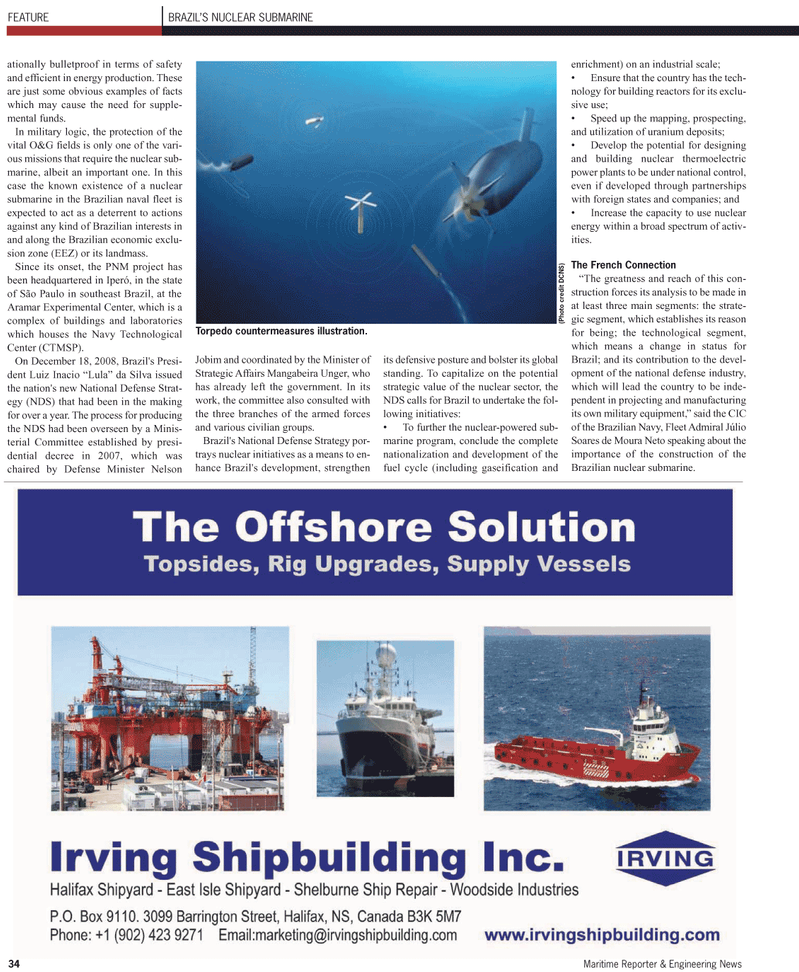
Page 34: of Maritime Reporter Magazine (April 2, 2010)
Read this page in Pdf, Flash or Html5 edition of April 2, 2010 Maritime Reporter Magazine
34 Maritime Reporter & Engineering News ationally bulletproof in terms of safety and efficient in energy production. These are just some obvious examples of facts which may cause the need for supple- mental funds.
In military logic, the protection of the vital O&G fields is only one of the vari- ous missions that require the nuclear sub- marine, albeit an important one. In this case the known existence of a nuclear submarine in the Brazilian naval fleet is expected to act as a deterrent to actions against any kind of Brazilian interests in and along the Brazilian economic exclu- sion zone (EEZ) or its landmass.
Since its onset, the PNM project has been headquartered in Iperó, in the state of São Paulo in southeast Brazil, at the
Aramar Experimental Center, which is a complex of buildings and laboratories which houses the Navy Technological
Center (CTMSP).
On December 18, 2008, Brazil's Presi- dent Luiz Inacio “Lula” da Silva issued the nation's new National Defense Strat- egy (NDS) that had been in the making for over a year. The process for producing the NDS had been overseen by a Minis- terial Committee established by presi- dential decree in 2007, which was chaired by Defense Minister Nelson
Jobim and coordinated by the Minister of
Strategic Affairs Mangabeira Unger, who has already left the government. In its work, the committee also consulted with the three branches of the armed forces and various civilian groups.
Brazil's National Defense Strategy por- trays nuclear initiatives as a means to en- hance Brazil's development, strengthen its defensive posture and bolster its global standing. To capitalize on the potential strategic value of the nuclear sector, the
NDS calls for Brazil to undertake the fol- lowing initiatives: • To further the nuclear-powered sub- marine program, conclude the complete nationalization and development of the fuel cycle (including gaseification and enrichment) on an industrial scale; • Ensure that the country has the tech- nology for building reactors for its exclu- sive use; • Speed up the mapping, prospecting, and utilization of uranium deposits; • Develop the potential for designing and building nuclear thermoelectric power plants to be under national control, even if developed through partnerships with foreign states and companies; and • Increase the capacity to use nuclear energy within a broad spectrum of activ- ities.
The French Connection “The greatness and reach of this con- struction forces its analysis to be made in at least three main segments: the strate- gic segment, which establishes its reason for being; the technological segment, which means a change in status for
Brazil; and its contribution to the devel- opment of the national defense industry, which will lead the country to be inde- pendent in projecting and manufacturing its own military equipment,” said the CIC of the Brazilian Navy, Fleet Admiral Júlio
Soares de Moura Neto speaking about the importance of the construction of the
Brazilian nuclear submarine.
FEATURE BRAZIL’S NUCLEAR SUBMARINE
Torpedo countermeasures illustration. (Photo cr edit DCNS)

 33
33

 35
35
